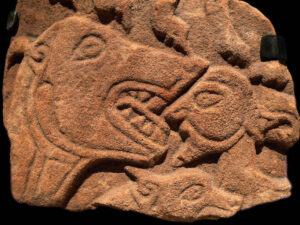
PLOS—The Picts of Scotland who have long intrigued and have been ascribed exotic origins in fact descended from indigenous Iron Age society and were genetically most similar to people living today in Scotland, Wales, North Ireland and Northumbria. Adeline Morez of Liverpool John Moores University and Linus Girdland-Flink of the University of Aberdeen report these findings in a new study* published April 27 in the journal PLOS Genetics.
The Picts, who inhabited early medieval Scotland from about 300-900 AD, formed the first documented kingdoms of eastern Scotland, but have often been a subject of mystery due to the lack of historical and archaeological evidence and due to their enigmatic symbol tradition inscribed on stone. In their new study, Morez and Girdland-Flink sampled Pictish burials to extract genomes to explore how the Picts are related to other cultural groups in Britain. They sequenced DNA from two individuals from central and northern Scotland that dated from the fifth to the seventh century AD. They compared the resulting high-quality genomes to more than 8,300 previously published ancient and modern genomes.
The analysis revealed that Picts descended from local Iron Age populations, who lived across Britain before the arrival of mainland Europeans. Additionally, the researchers found genetic similarities between the Picts and present-day people living in western Scotland, Wales, Northern Ireland and Northumbria. Medieval traditions, including from the time of the Picts themselves, had ascribed exotic origins to the Picts including them coming from Thrace (north of the Aegean Sea), Scythia (eastern Europe), or isles north of Britain, but the new research suggests much less sensational origins.
A further analysis of DNA sequenced from seven individuals interred in a Pictish cemetery showed that the individuals did not share a common ancestor on their mother’s side. This finding suggests that females may have married outside their own social group and runs counter to older speculation, such as that mentioned by the great English scholar Bede, that the Picts were matrilineal; that they had had a society based on kinship through the mother’s lineage.
The new findings support current archaeological theories that Picts descended from Iron Age people in Britain. The study also provides novel insights into the genetic relationships that existed amongst Pictish individuals buried in cemeteries together and between ancient Picts and present-day groups in the United Kingdom.
_____________________________

Detail of a stone carved Pictish monument. F Lamiot, Public Domain, Wikimedia Commons
_____________________________
Article Source: A PLOS news release
*Morez A, Britton K, Noble G, Günther T, Götherström A, Rodríguez-Varela R, et al. (2023) Imputed genomes and haplotype-based analyses of the Picts of early medieval Scotland reveal fine-scale relatedness between Iron Age, early medieval and the modern people of the UK. PLoS Genet 19(4): e1010360. https://doi.org/10.1371/journal.pgen.1010360
_____________________________
Advertisement
_____________________________

Don’t miss out on this unforgettable evening as Dr. Hawass reveals the most closely guarded secrets of ancient Egypt and presents his groundbreaking new discoveries and latest research live on stage. As the man behind all major discoveries in Egypt over the last few decades and director of several ongoing archaeological projects, Dr. Hawass may yet surprise you with unexpected revelations that will make news across the world.
_____________________________



